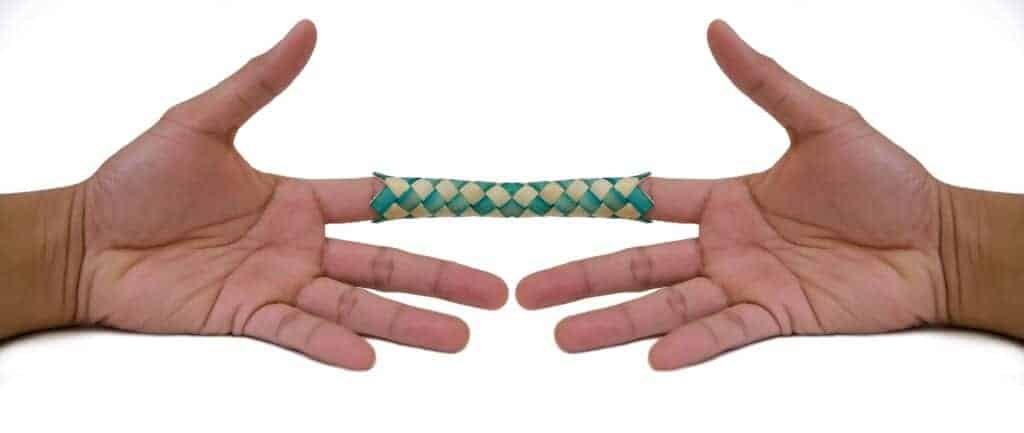People who don’t struggle with anxiety often write it off as “nerves.”
What they don’t know is that anxiety can be completely debilitating. It can become all-encompassing. It can cause you to spiral and drown.
However, it doesn’t have to.
We’re here to give you the tools to manage and reduce anxiety and help you channel the energy of anxiety to propel you forward toward actions, even excitement.
Your particular toolkit may include many things. Weekly therapy, for example, and daily self-care and techniques for emotional regulation.
One surprising thing to add to your anxiety-care toolkit? Familiarize yourself with the metaphors for anxiety used below. They’ll help you understand anxiety and how we all tend to react to it.
These metaphors for anxiety can help affirm and contextualize the way you’re feeling. They can help you make another choice when anxiety pops up.
Read up on the 3 metaphors for anxiety that help understand anxiety.
Metaphor 1: The Chinese Finger Trap

Chinese finger traps are woven paper tubes. To “trap” yourself, you place one index finger in each end of the tube.
When you pull your fingers away from each other, the tube gets tighter. Your fingers get stuck. The more you pull away, the more uncomfortable it gets.
Anxiety works very similarly.
Leaning into your anxiety — much like relaxing into a Chinese finger trap — can give you the wiggle room you need to walk away from this type of challenging situation more peacefully.
Anxiety relief is counterintuitive. Running away from it doesn’t quite work. The way out is through. By relaxing into into it, creating spaciousness for it, the intensity of the anxiety plummets.
As we return to calm we bring presence to whatever is present within us in that moment.
Metaphor 2: Quicksand

Quicksand is a patch of sand that seems firm at first, but gives way after you step into it, sucking you in until you drown. Sinking into quicksand is an archetypal fear.
The thing about quicksand is that, like the Chinese finger trap, the harder you struggle once you’re caught in it, the faster you sink. The best strategy for escaping quicksand is to relax, lay back, and float on top of it.
In other words, relaxing into quicksand and leaning into the discomfort… works.
When was the last time you were in a difficult situation, and struggling only made things worse?
Mediation Exercise:
Visualize yourself on quicksand.
Breathe in deeply.
After the urge of fighting your way out of the quicksand passes, relax into it deeply.
Bring your body to a standstill.
Continue breathing deeply with slow inhale and even deeper exhale.
Visualize yourself at peace in the quicksand. Stay with that image a while longer until you start to feel sensations on your body.
Pay attention to all those sensations and visualize yourself being lifted out of the quicksand and now hovering over it.
Stay with your sensations and feelings.
Looking For Therapy?
Start Healing Today.
212-960-8626
Metaphor 3: The Baby Tiger

Who wouldn’t love to cuddle a tiny baby tiger? It’s young, it’s adorable, it seems harmless.
On some level, you’d realize that sooner or later that little tiger is going to grow up and be a powerful, wild beast that could easily overpower you. But not today – the transformation from harmless kitten to dangerous predator is a gradual one.
How does this translate to anxiety?
Sometimes, we don’t realize at first that our anxiety is a problem. As we feed it, however, it slowly grows bigger and more powerful. To keep it small and manageable, we need to stop feeding it, and we need to develop strategies for training it.
The time to begin withholding food for the ruminative, disaster-oriented thinking that sets it going and learning control techniques is not when it’s a snarling, 300-lb. menace. It’s early, when it’s still small and you’ve still got the upper hand.
We are creatures of habits. Debilitating anxiety does not develop all at once. It is reinforced through repetitive patterns. Best to learn health habits now before the anxiety becomes crippling.
Throughout the day, we have several opportunities to reinforce good habits or to fall back into the maladaptive habits of the past.
In every now moment, we choose, albeit not always consciously.
We can choose to feed our internal peace, our sense of joy, to develop our inner calm or we can choose give in to anxiety and the habits associated with it.
Make a conscious choice. Choose wisely.

Ready to discover your Anxiety Type?
Finger Traps, Quicksand, and Baby Tigers: The Common Denominator
Our metaphors for anxiety represent the same underlying problem. They’re all ultimately about avoidance.
When we experience anxiety, we want to avoid feeling bad. We don’t want to feel stuck, or like we’re drowning, or that we’re in danger.
So we try to run away. We pull in the opposite direction from our anxiety. We avoid taking uncomfortable but needed action.
Here’s the truth, though: Running away from anxiety will only make it worse.
Avoidance and distraction can only take us so far.
Instead of fighting our way out of anxiety, we need to face it. We need to feel it. We need to enter into dialogue with it and come to peace with it.
The only way out of anxiety is through.
We know that’s easier said than done. And leaning into anxiety can feel scary. Fortunately, you don’t have to do the work alone.
At Manhattan Mental Health Counseling, we offer easy, affordable, and skilled online therapy across New York and New Jersey. Contact us today to be matched with an anxiety therapist.
